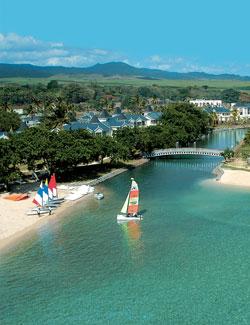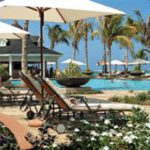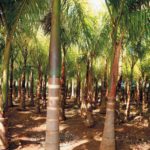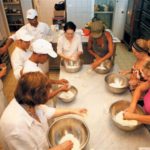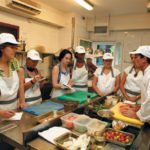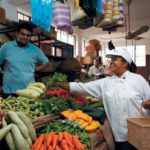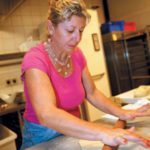Food & Home Entertaining’s food editor ANNA MONTALI relished a delicious visit to L Telfair Golf & Spa Resort where she cooked Mauritian cuisine with the experts
ANNA MONTALI
What can I say about Mauritius that you don’t already know? This is one island that has been talked about more than any other holiday destination I’m aware of: lots of sunshine, long sandy beaches, hours of relaxation and, travelling from South Africa, you don’t have to fly for hours to experience paradise.
I accepted a media invitation to Mauritius and this time it was quite different – we were going to cook. Cooking tours have become very popular over the years and even though Mauritius is not usually regarded as a cooking destination you can, while enjoying your holiday, spend an hour or two learning how to prepare a few local dishes.
Tucked away in the unspoiled southern part of the island in the former Bel Ombre sugar estate is Le Telfair Golf & Spa Resort. Once home to Irish surgeon and renowned botanist, Charles Telfair and his wife Annabella, Le Telfair overlooks the warm waters of the Indian Ocean on one side and the foothills of the majestic Plaine Champagne mountains on the other. The resort has been extensively refurbished but remains in the style of its original colonial beauty. It is also very cleverly designed so that the Citronnier and St Martin rivers run through the resort, with some stunning picturesque stone and rustic wooden bridges. Inside the hotel every detail has been considered to offer guests the ultimate holiday experience.
My first day started with a short trip to Charles Telfair’s home, Le Château, which has been restored and converted into a restaurant to offer hotel guests a fine-dining experience. Chef-patron Bernard Gouerec was there to greet us and informed us that he would be co-ordinating our cooking experiences. The kitchen is fairly small but well equipped, and one of its main attractions is a stunning set of Staub cast-iron cookware, which we would be using. These pots are said to be indestructible and, I believe, provide excellent cooking results (how I would love a set in my kitchen!) Armed with apron and cap, I was more than ready to start with our first lesson.
Bernard introduced us to two dishes: a fish starter using fillet of ombrine, a white-fleshed fish found in the hotel’s lagoon. The second dish, fillet of deer (the culling season runs from June to September in Mauritius), was something I had never tasted before and was eager to do so. We braised the fish with mustard and some local spices – curry leaves and an ingredient known as “4 épices” or four spices. The fillet of deer was roasted with a delicious guava sauce using small green guavas and chillies.
We also learned how to turn thinly sliced breadfruit into stunning deep-fried “baskets”. I thought we could do the same with pumpkin or butternut back in South Africa where breadfruit is not available. All you do is thinly slice the breadfruit and place it in a metal sieve of your desired shape. Deep-fry it quickly; this will form a “basket” which can be used as a serving vessel. We had loads of fun in the kitchen as well as in the well-established herb and vegetable garden where we had the opportunity to take a closer look at the breadfruit and palms, and a stunning bush of okra, also known as lady’s fingers.
Relaxing prior to lunch we were able to take in the picturesque view over the distant Bel Ombre Sugar Estate nature and deer reserve. The reserve is about 15 000 hectares and boasts forests, sparkling waterfalls, flora and fauna. It’s ideal for outdoor sports enthusiasts who enjoy hiking, cycling, mountain biking, quad riding as well as deer and birdwatching. Our lunch venue was equally fabulous and sitting under a magnificent tree in the garden of Le Château we enjoyed the meal we had helped to prepare.
Our afternoon cooking lesson was at Annabella’s, the hotel’s main restaurant, where Mauritian-born chef Thierry Sewoo (who spent a year cooking with Gordon Ramsay) introduced us to some amazing local flavours. It was the first time that I had the opportunity to see and touch a huge palm heart. In South Africa we can get palm hearts in tins and they’re not readily available fresh so I relished this rare opportunity. We were also told that palm hearts discolour easily and that it’s best to pour some lemon juice over to prevent them from turning brown.
The following day was overcast and rainy, but we headed off to the Chemin Grenier market, where the villagers sell their fresh produce once a week. I found this particular market rather small compared to some of the bigger markets on the island such as Port Louis’s. I love food markets and enjoyed the chance to smell and touch some of the good-looking fresh produce. We bought some of the more unusual vegetables so that back at the hotel Thierry could prepare them for tasting.
On our return we met executive pastry chef Benoit Rodriguez (who was previously at Singapore’s Raffles Hotel) for our next class – baking and desserts. I was amazed at the small kitchen area, how well prepared and compact it all was – and especially the amount of baking products that went out of that kitchen. We prepared roasted pineapple with mascarpone cream and crispy nougatine as well as a banana pizza with fresh coconut and chocolate rum and raisin ice cream. We also did two ways with praline.
While all this was going on we watched the preparation of French baguettes in time for the lunch-hour rush – it was incredible. One thing you have to realise about Mauritius is that its high humidity levels mean baking can sometimes become quite tricky. We were all very eager for our next class, the theme of which was “Along the Indian Spice Route” with Indian chef Vikash Luchmineea. Here we learned about two dishes, a calamari salad flavoured with saffron and Indian spices, and a typical dish, spiced tandoori-roasted chicken.
Our third day was spent enjoying a morning of leisure on a boat ride out to the reef and over to Le Morne Brabant, which is a peninsula at the far end of Le Telfair. Here a huge single standing basaltic rock with a summit 556m above sea level offers one of the most imposing sights on the island. After a refreshing dip, sipping French champagne and savouring delicious snacks, we were ready for our final class. Chef Hiroyuki Tamagawa (aka Hiro San) heads up Gin’ja, the resort’s seafood restaurant, where I enjoyed a superb meal. Built on a stretch of white sand, the restaurant is located in an informal beachside setting. Hiro gave us the opportunity to roll sushi and create some California rolls, which we enjoyed afterwards. All too soon the lessons came to an end and after enjoying green island rum cocktails it was adieu to a culinary experience that’s one of my most memorable.
Hands-on cooking classes at Le Telfair Golf & Spa Resort are conducted for five people, or 15 – 20 people for demonstrations. Culinary demonstrations are held three days a week in the resort’s different kitchens and are free of charge to hotel guests. Each class or demonstration lasts about two hours.
Anna Montali was hosted by Le Telfair Golf & Spa Resort, www.letelfair.com Thompsons Tours and the Mauritian Tourist Authority. www.tourism-mauritius.mu.
SOURCES
ELIE BERNAGER

